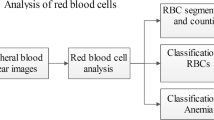Abstract
The objective of this study was to evaluate the performance of the CELL-DYN® 3500 for rat and mouse blood analysis in a routine environment. The WBC (white blood cells), RBC (red blood cells), PLT (platelets) counts and the WBC differential were determined. In addition, the following aspects were studied: within-run precision, day-to-day precision, biasfree paired difference precision; extended ranges of linearity for RBC, HCT (haematocrit), WBC, PLT; carry-over, the fffect of blood ageing, cell stability with different anticoagulants; and the normal ranges, the out of range flagging and some typical pathology cases.
The CELL-DYN® 3500 is a multiparameter flow cytometer which counts and differentiates WBC, based on the principle of multi-angle polarised light scatter separation. RBC and PLT are determined by the impedance method. The WBC count is evaluated by both, optical and impedance methods. Reference methods used were according to the ICSH recommendations on blood cell analysis, including manual counts of WBC and platelets, a centrifugal microhaematocrit method and a haemoglobin measurement by spectrophotometry using the WHO haemoglobin standard. All cell counts were compared with the results obtained by our routine blood cell analyser (Contraves AL820), and the WBC differential was compared with the manual microscopic differentiation of the 400 WBC (200 cells differentiated by two technicians).
The following coefficients of variation were obtained: within-run precision was 1.2% and 2.7% for WBC; 1.0% and 1.0% for RBC; 1.3% and 0.9% for haematocrit; 2.1% and 2.7% for platelets (rats and mice respectively). Day-to-day precision was performed using human trilevel control blood, and the CVs were found to be <1.7% for WBC, <1.4% for RBC, <1.2% for haemoglobin and <6.3% for platelets.
The following ranges of measurement were found to be linear in the rat: WBC: 0.10–20.20×103/μl; RBC: 0.016–14.3×106/μl; haemoglobin: 0.08–26.8 g/dl; haematocrit: 5.0%–77%; platelets: 14.0–1670.0×103/μl. Equal ranges were observed for mouse blood. Carry-over in rat blood was found to be 0.12% for WBC, 0.05% for RBC, 0.15% for haemoglobin and 0.46% for platelets. In mice, similar carry-over results were obtained. The correlation coefficients (Pearson, correlation coefficient) between the CELL-DYN® 3500 and Contraves AL 820 using linear regression analysis were as follows: 0.988 and 0.997 for WBC; 0.986 and 0.920 for RBC; 0.995 and 0.984 for haemoglobin; 0.958 and 0.85 for haematocrit; 0.958 and 0.963 for platelets, for rats and mice, respectively. Correlation coefficients between the CELL-DYN® 3500 and the manual differential of NEU (neutrophils) and LYM (lymphocytes) were higher than 0.8 in rats and higher than 0.9 in mice. Due to the relatively low absolute counts of MONO (monocytes), EOS (eosinophils) and BASO (basophils), only moderate correlation of methods was found.
The CELL-DYN® 3500 was judged to be reliable, accurate and easy-to-use for counting and identifying normal and most of the pathological blood specimens obtained from mice and rats. By using the CELL-DYN® 3500, the time for blood sample analysis can be shortened significantly and provides extensive opportunities to characterise pathological samples.
Similar content being viewed by others
References
Bablok W, Passing H (1985) Application of statistical procedures in analytical instrument testing. J Aut Chem 7(2):74–79
Bland M (1991) An introduction to medical statistics. Oxford University Press, Oxford
Bollinger PB, Drewinko B, Brailas CD et al. (1987) The Technicon H*1—an automated hematology analyzer for today and tomorrow. Am J Clin Pathol 87:71–78
Broughton PMG, Gowenlock AN, McCornack SS et al. (1974) A revised scheme for the evaluation of automated instruments for use in clinical chemistry. Ann Clin Biochem 11:207–212
Bull BS (1975) A statistical approach to quality control. In: Lewis JM, Coster JF (eds) Quality control in haematology, 2nd edn. Academic Press, New York.
Coulter WH (1956) High speed automatic blood cell counter and cell analyzer. Proc Natl Electron Conf 12:1034
Davis DT, Fisher GV (1991) The validation and application of the technicon H*1 for the complete automated evaluation of laboratory animal haematology. Comp Haematol Int 1:91–105
Devreese K, De Logi E, Francart C et al. (1991) Evaluation of the automated haematology analyser Sysmex NE-8000. Eur J Clin Chem Clin Biochem 29:339–345
FELASA (Federation of European Laboratory Animal Science Associations) (1994) Recommendations for the health monitoring of mouse, rat, hamster, guinea pig and rabbit breeding colonies. Report of the Federation of European Laboratory Animal Science Associations Working Group on Animal Health accepted by the FELASA Board of Management November 1992. Lab Anim 28:1–12
ICSH (International Committee for Standardization in Haematology) (1984) Protocol for evaluation of automated blood cell counters. Clin Lab Haematol 6:69–84
Mann HB, Whitney JR (1947) On a test of whether one of two random variables is stochastically larger than the other. Ann Math Statist 18:50–60
Passing H, Bablok W (1983) A new biometrical procedure for testing equality of measurements from two different analytical methods. J Clin Chem Clin Biochem 21:709–720
Van Assendelft OW, England JM (1992) Advances in haematological methods: the blood count. CRC Press Boca Raton, Florida.
Van Leewen L, Eggels PH, Bullen JA (1991) A short evaluation of a new haematological cell counter—the Cell-Dyn 300—following a modified tentative NCCLS-procedure. Eur J Clin Chem Clin Biochem 29:105–110
Weingand KW, Odioso LW, Laytart MJ et al. (1990) Hematology analyzer comparison: Ortho ELT-8 versus Baker 9000 for healthy dogs, rats, and mice. Vet Clin Pathol 20:21–22
Winkler GC, Engeli E, Rogg E et al. (1995) Evaluation of the Contraves AL 820 automated haematology analyser for domestic, pet and laboratory animals. Comp Haematol Int 5:130–139
Author information
Authors and Affiliations
Rights and permissions
About this article
Cite this article
Kieffer, J., Winkler, G., Van Hove, L. et al. Evaluation of the CELL-DYN® 3500 haematology instrument for the analysis of the mouse and rat blood. Comp Haematol Int 9, 92–106 (1999). https://doi.org/10.1007/BF02585543
Issue Date:
DOI: https://doi.org/10.1007/BF02585543




